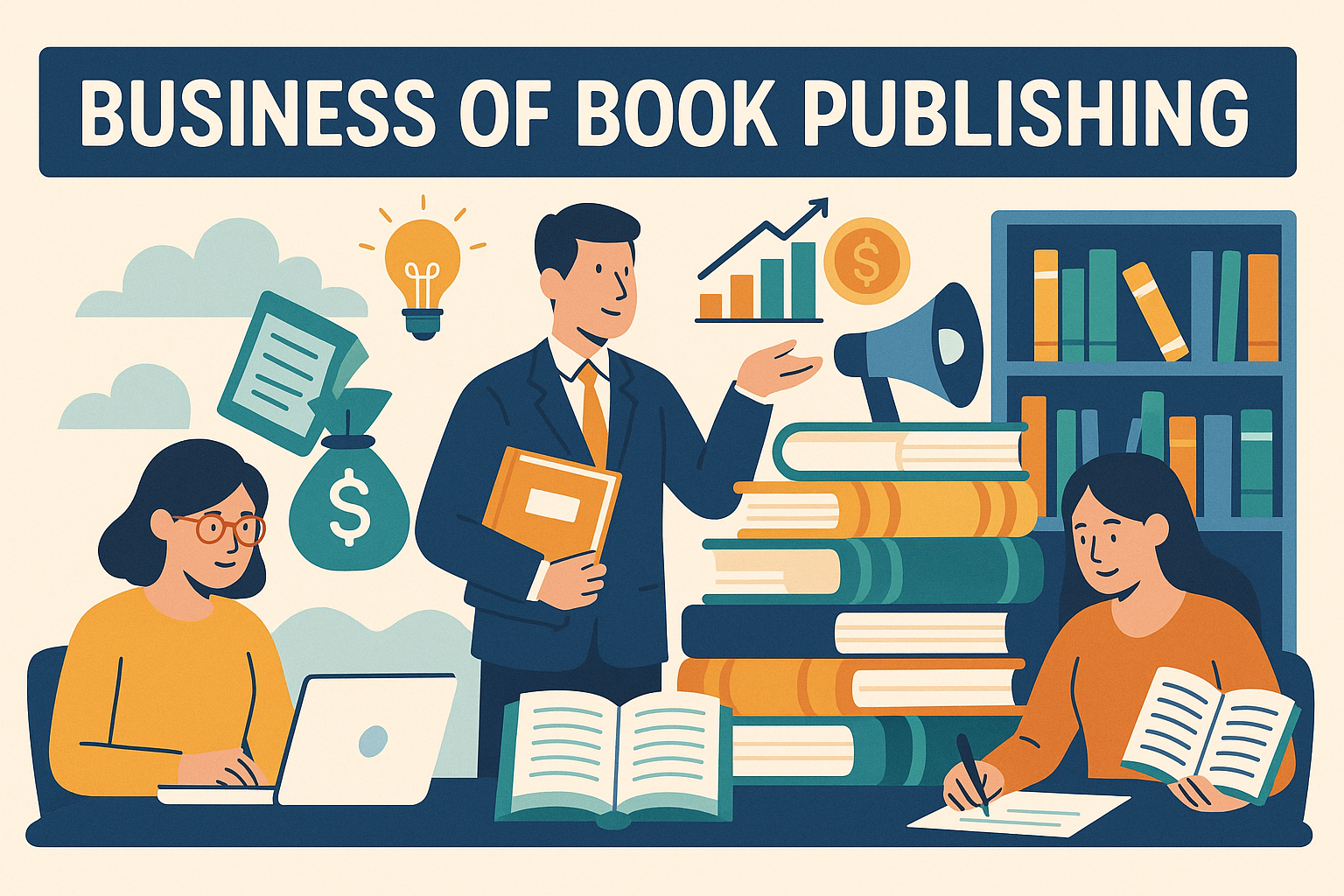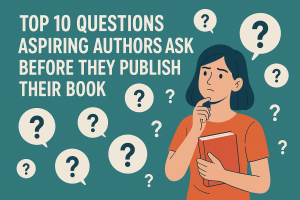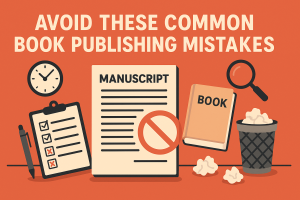For many aspiring authors, writing the manuscript feels like the biggest hurdle. But in truth, finishing your book is only the beginning. Entering the world of book publishing is a business decision, and like any successful business, it requires planning, investment, partnerships, and an understanding of how to generate profit from your creative product.
Whether you’re a novelist, a business leader sharing industry insights, or a parent with a dream of launching a Children’s Book publishing brand, understanding how to turn your words into income requires strategic publishing knowledge. This guide will walk you through the entire process of publishing your book—from idea to profit—while helping you identify the best book publishing services for your needs.
Understanding the Modern Book Publishing Landscape and How It Has Evolved into a Full-Fledged Business Industry
The book publishing industry has evolved dramatically in the last two decades. Once dominated by a small number of major publishing houses, today’s landscape offers a spectrum of options for aspiring authors. From traditional publishing to self-publishing and hybrid models, every author now has multiple paths to bring their work to market.
This transformation has turned authors into entrepreneurs. Understanding this shift is critical. When you publish a book, you aren’t just releasing a story—you’re launching a product into a competitive marketplace. To succeed, you must think like a publisher, marketer, and brand builder.
This is especially true in niches like Children’s Book publishing, where illustrations, age-specific formatting, and school distribution can determine a book’s success. From pricing strategy to digital sales optimization, today’s book publishing world is more than a literary venture—it’s a business.
Exploring the Different Models of Book Publishing and How Each Affects Ownership, Control, and Profit Potential
There are three primary models of book publishing, and your profit potential depends heavily on the path you choose:
1. Traditional Publishing Model
In this model, you submit your manuscript to a book publishing company (usually via an agent), and if accepted, they handle everything—editing, design, marketing, and distribution. However, they also retain most of the rights and royalties. While this method gives you prestige and wide distribution, your profits per book sold are relatively low.
2. Self-Publishing Model
This model allows authors to retain control of their rights, pricing, and branding. Authors partner with platforms or book printing companies, handle their own editing and marketing (or hire freelancers), and earn higher royalties per sale. It’s ideal for entrepreneurial authors with niche audiences, especially those looking to maximize profits.
3. Hybrid or Assisted Publishing
These are book publishing services that offer professional support for editing, formatting, and marketing—typically in exchange for a fee. Authors retain more rights than in traditional publishing but get professional results. Many of the best book publishing services today fall into this category, offering a balance of control and quality.
Each model suits different goals. A children’s author may opt for hybrid publishing to get high-quality illustrations, while a nonfiction author may pursue traditional publishing to leverage industry credibility.
Choosing the Right Book Publishing Company and Why Your Decision Will Affect Your Brand, Budget, and Bottom Line
The choice of a book publishing company can determine not just how your book looks, but how it performs. An experienced publishing company will help position your book correctly in the marketplace, identify your target readers, and ensure that your project is professionally presented.
When choosing a company, evaluate the following:
-
Do they specialize in your genre or niche (e.g., Children’s Book publishing)?
-
Do they have a track record of helping authors succeed commercially?
-
What services are included—editing, design, ISBN assignment, and distribution?
-
Do they offer transparent royalty structures and clear contracts?
If you’re looking for a partner that understands both storytelling and profit-building, seek out the best book publishing services that focus on author support, transparent pricing, and marketing execution.
The Critical Importance of Professional Editing and Why It’s a Non-Negotiable Investment for Profit-Driven Publishing
One of the most common mistakes self-published authors make is skimping on editing. A poorly edited book will not only earn negative reviews but also fail to generate word-of-mouth buzz.
There are four levels of editing you should consider:
-
Developmental Editing – For structure, content flow, and organization
-
Line Editing – To refine sentence structure, pacing, and clarity
-
Copyediting – For grammar, punctuation, and language consistency
-
Proofreading – Final quality check before printing
Professional book publishing services typically include these as part of their packages or offer them as add-ons. Investing in editing increases your chances of strong reviews, repeat readers, and long-term profitability.
How to Create a Market-Ready Book Design That Attracts Readers and Reinforces Your Brand as an Author
Book design includes cover design, interior layout, typography, and illustrations (if applicable). For genres like fantasy or Children’s Book publishing, the visual design is especially critical.
A compelling book cover grabs attention and suggests quality. Your interior layout should support readability across formats (print and digital). For children’s books, illustrations must match the tone and developmental level of the reader.
When reviewing book publishing company options, ensure they offer design expertise or work with trusted creative teams. Good design sells—and great design builds a recognizable author brand.
Printing and Production Decisions You Must Make and How Book Printing Companies Impact Quality and Profit
Once your book is edited and designed, it must be printed or formatted for digital platforms. For printed copies, your choice of book printing companies matters significantly.
Important factors to consider:
-
Print-on-demand vs. bulk printing
-
Hardcover, paperback, and specialty binding options
-
Paper quality, trim size, and color printing (especially for children’s books)
-
Shipping logistics and fulfillment options
Working with reputable book printing companies ensures your final product reflects your investment and meets industry standards. Poor print quality can ruin a reader’s experience—and hurt your credibility as an author.
Crafting a Strategic Book Launch Plan That Combines Marketing, Publicity, and Reader Engagement
A successful book launch requires more than pressing “publish.” You’ll need a full launch plan that includes pre-launch buzz, launch-day promotion, and post-launch momentum.
Essential elements:
-
Advanced Reader Copies (ARCs) and review campaigns
-
Social media marketing and author branding
-
Email marketing to your subscriber base
-
Amazon optimization (keywords, categories, metadata)
-
Partnerships with influencers, bloggers, or educators (for Children’s Book publishing)
Many of the best book publishing services offer marketing support. If you’re managing this yourself, invest in a marketing plan that builds visibility and connects your book to its audience.
Leveraging Book Publishing Services to Expand Distribution and Reach Global Audiences for Maximum Sales
Distribution is the process of getting your book into readers’ hands, whether through Amazon, bookstores, schools, or libraries. Your book should be available where your audience shops.
Distribution strategies differ by format:
-
Print: Work with book publishing company partners who distribute to Ingram, Baker & Taylor, and retail outlets.
-
eBook: Use platforms like Kindle Direct Publishing, Apple Books, Kobo, and Google Play.
-
Audiobook: Partner with Audible, Findaway Voices, or Chirp.
By using comprehensive book publishing services, authors can access global platforms without needing separate contracts with each distributor. Broad distribution increases revenue potential.
Understanding Royalties, Pricing Models, and Profit Margins to Maximize Your Earnings as an Independent Author
Profitability in book publishing depends on understanding how royalties and pricing work. Traditional publishing pays royalties in the 8–15% range, while self-publishing platforms may offer 35–70%.
You’ll need to:
-
Set your print and eBook prices strategically
-
Account for printing costs, distribution fees, and marketing spend
-
Balance affordability with perceived value
-
Offer promotions or bundling strategies (e.g., print + digital)
The more control you have—typically with self or hybrid book publishing services, the more profit you retain. Understanding your numbers helps you build a sustainable author business.
Building an Author Brand That Grows Beyond a Single Book and Supports Long-Term Profit and Recognition
One book can launch a career—but only with an author brand behind it. Treat your writing career as a business and your name as a brand.
Key branding steps:
-
Build a professional website and email list
-
Establish a consistent voice and message across platforms
-
Create content beyond the book (e.g., blog, podcast, YouTube)
-
Publish follow-up books, special editions, or workbooks
Children’s authors may also create merchandise, lesson plans, or activity kits. Branding increases reader loyalty and helps you monetize beyond book sales.
Why Children’s Book Publishing Requires Specialized Knowledge and How to Navigate It Successfully
Children’s Book publishing is a unique corner of the industry with its own rules and reader psychology. From age-appropriate vocabulary to illustration choices, publishing for kids demands expertise.
Key things to consider:
-
Age categories (board books, picture books, middle grade, etc.)
-
Rhyming structure, font size, and pacing
-
Educational standards for school adoption
-
Parental appeal and librarian recommendations
Seek book publishing services that specialize in this area or have published successful children’s titles. Your profit margin in this space can grow with licensing, educational contracts, and foreign rights.
Case Studies of Successful Books That Became Profitable Publishing Ventures and What You Can Learn from Them
Look at success stories like:
-
Indie authors who built entire empires from self-publishing
-
Nonfiction authors using books to fuel speaking and consulting
-
Children’s book creators expanding into TV or merchandise
In nearly every case, authors treated their books like businesses. They partnered with book publishing services wisely, invested in quality, built platforms, and created diversified income streams.
Conclusion: Treating Book Publishing Like a Business Is the Key to Profit, Longevity, and Fulfillment as an Author
Publishing a book is no longer just about getting your story into the world—it’s about doing so in a way that is sustainable, strategic, and financially rewarding. Whether you work with a book publishing company, pursue independent publishing, or use the best book publishing services, your success depends on your willingness to treat your book as a product and your author career as a business.
From planning to promotion, printing to profit—every step matters. If you invest in the right partnerships, especially those experienced in book publishing, book printing companies, and distribution channels that suit your genre, your book can become more than just a dream fulfilled—it can become a thriving enterprise.






